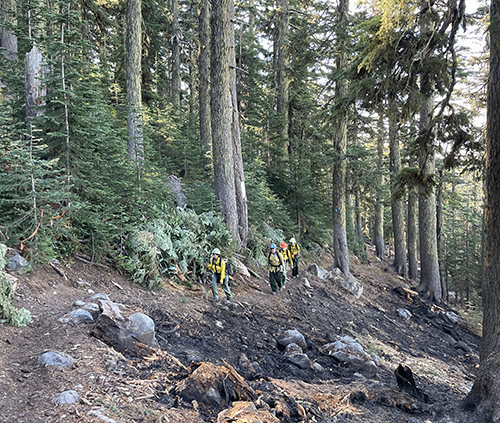Reporter for The Canyon Weekly
Change is coming once again to the national forests supervised by the U.S. Department of Agriculture and its U.S. Forest Service subsidiary.
Agriculture Secretary Tom Vilsack on Dec. 19 announced plans by the department to amend the 1994 Northwest Forest Plan in an effort to conserve and steward old-growth forest conditions on national forests and grasslands. The proposal covers 25 million acres of old-growth forests, 68 million acres of mature forest and all 128 forest land management plans currently in place.
“Old-growth forests are a vital part of our ecosystems and a special cultural resource,” Secretary Vilsack said in a statement released by the department. “This proposed nationwide forest plan amendment – the first in the agency’s history – is an important step in conserving these national treasures. Climate change is presenting new threats like historic droughts and catastrophic wildfires. This clear direction will help our old-growth forests thrive across our shared landscape.”
Other federal officials echoed Vilsack’s climate urgency.
“Our forests absorb carbon dioxide equivalent to more than 10 percent of our nation’s annual greenhouse gas emissions,” said White House council on environmental quality chair Brenda Mallory. “Under President Biden’s leadership, our administration is acting to conserve and restore old-growth forests so nature can continue to be a key climate solution.”
American Forest Resource Council President Travis Joseph sharply criticized the move by the Biden administration.
“(We are) reviewing the Forest Service’s (notice) and will submit substantive comments,” he said. “On the surface, however, the proposed policy fails to take meaningful steps to address the true risks to old-growth forests on National Forest system lands – specifically severe wildfires, insect infestations and disease that have already destroyed nearly 700,000 acres of old-growth forests on federal lands over the past 20 years.
“The Forest Service’s data confirms logging poses a negligible threat to old-growth forests, and existing federal environmental laws and forest plans provide direction on managing and protecting old growth. Yet the agency is now being directed to embark on a new, massive bureaucratic process – during a wildfire and forest health crisis – that will likely make forest management more complex, costly, and contentious.”
More than 1 million acres of the nation’s stock of old-growth and mature forests are in Oregon, Washington and Northern California (see map) and were previously set aside for logging.Those tracts will be reviewed as part of the amendment.

No word was available on how much of that acreage lies in the Willamette National Forest or its Detroit District in the Santiam Canyon. Officials at the Detroit Ranger Station and those at the main Willamette National Forest office in Springfield did not respond by The Canyon Weekly presstime to requests for information on the local impact.
Healthy, climate-resilient old-growth forests store large amounts of carbon, increase biodiversity, reduce wildfire risks, enable subsistence and cultural uses, provide outdoor recreational opportunities and promote sustainable local economic development, read the press release from Vilsack’s office. Land management plans provide direction for how national forests and grasslands are managed for their many uses, including conservation. The proposed amendment, the statement said, will use the best available science, including indigenous knowledge, to provide consistent direction related to old-growth forest conditions across national forests and grasslands.
The Agriculture Department also formed a 21-member forest advisory committee to provide advice and recommendations on amending the forest plans. The committee will participate in three days of meetings at University of Oregon from Jan. 30 through Feb. 1 (see timeline below for details).
The committee consists of members in four categories.There are 9 scientists, including representatives of Oregon State University, the University of Oregon and the University of Washington. There are eight members of organizations such as the American Forest Resource Council and the Wilderness Society and four individuals from public and governmental agencies such as the Oregon Department of Fish and Wildlife. Three of the committee members have tribal affiliations.
“Establishing this committee is another way for us to embrace climate-smart science, ensure we hear from diverse voices and get a range of perspectives on how to best confront the wildfire crisis and climate change,” said Tom Vilsack. “This committee will also be asked to help reshape ways we engage with communities and deepen our connections with tribes as we go through the Northwest Forest Plan amendment process.”
The Northwest Forest Plan (NWFP) was adopted in 1994 with the intent of protecting the critical habitat of the northern spotted owl while maintaining a viable forest products industry in the Pacific Northwest. The NWFP amended 26 land use plans, including 17 National Forest and seven Bureau of Land Management (BLM) plans across Washington, Oregon and California within range of the northern spotted owl.
The NWFP established standards and guidelines to meet the intent to pursue an ecosystem-managed, scientifically supported approach to forest management. The goal is to maintain healthy forest habitat to support native species, watershed health and function, and a sustainable supply of timber and other forest products to help preserve the stability of local and regional economies.
PUBLIC MEETING TIMELINE
Jan 30 – Feb. 1: 3 days of Federal Advisory Committee meetings at University of Oregon, 1395 University St., Eugene. Jan. 30 and Jan. 31 sessions are 9 a.m. – 4 p.m. and Feb. 1, 9 a.m. – noon. Public comment will be taken at the meetings and a zoom option is available. Written public comments are due by Jan. 24 via email at [email protected] or by postal mail to Katie Heard, USDA Forest Service, 1220 SW Third Ave., Ste. GO15, Portland, OR 97204. You can sign up to speak at one of the public sessions by alerting Heard at either the email or postal address.
June, 2024: The environmental impact statement (EIS) on the amendment is due, followed by a 90-day public comment period.
October 2024: The final EIS is expected.
**********************
State Process
Oregon also is working on a plan that will affect state properties managed by the Oregon Department of Forestry (ODF).
A habitat conservation plan for Western Oregon is underway, with the goal of ensuring that private forest properties and logging practices are linked to the survival of aquatic species.
The ODF plan is due by 2027. The work is required by state legislation passed in 2022 and the Private Forest Accord (PFA) that revised forest practices.
A key outcome of the process will be the establishment of “incidental take permits,” which would recognize that the harming or killing of aquatic species protected by the Endangered Species Act (ESA) can occur even when the forest practices involved were legal.





